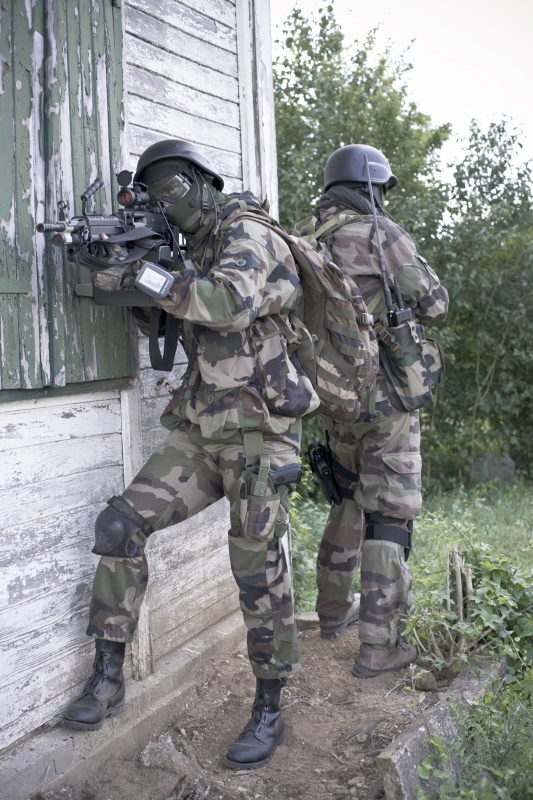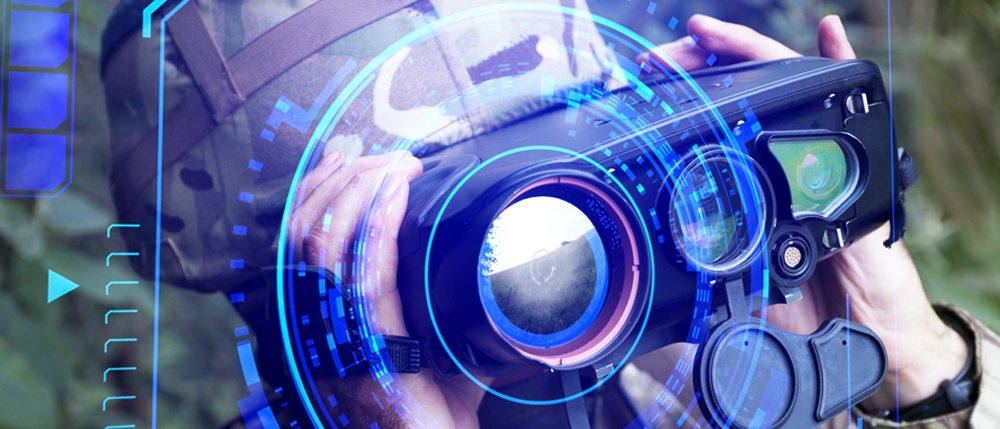Tomorrow's soldier today
For the military, there is little more important than ensuring the forces in the field have the best available equipment at the right time, if they are to be as safe and effective as they can be. The threats they face continue to evolve and tomorrow’s soldier will need to be properly equipped in order to anticipate them. Fully networked communication technologies and advanced materials are driving the change.
[This article is an extract from "Innovations #3"]
Recent flashpoints in the Middle East,
Africa and Eastern Europe have demonstrated that warfare as we once knew it is no longer straightforward, with conventional forces facing off in a black and white battle for territory.
Insurgents are far more likely to be part of a scattered, unconventional force, unrecognisable from the columns and battalions of the past. Many soldiers now find themselves up against a hidden enemy, using the urban environment to sow confusion and disorient their opponent.
Commanders and planners acknowledge that simply employing overwhelming firepower eventually suffers diminishing returns. Ultimately, you need ground forces to win the fight. If scale and scope won’t meet the challenge, clearly something else is needed – a solution that combines smarter deployment of targeted weapons, beefed up protection for exposed forces, and greater integration and connectivity in what is a confusing and dangerous theatre of war.
And it all needs to be carried by the average soldier.
Fit for purpose

Thomas Reydellet, director of strategic advanced studies at Thales Research & Technology, says that, in the very near future, “soldiers will need a high degree of autonomy (in terms of logistics, ammunitions, chargers and batteries) for extended missions against hybrid, extremely adaptable enemies (for which a lot of ordnance is required because they are hidden, agile and fleeting). Sharing tactical information in real time will be vital to create a common operational picture between all different military assets on the battleground – UAV, Vehicles, fighters – not least to limit friendly fire and reduce uncertainty.”
For the men and women tasked with deploying these new technologies, the future looks increasingly digital. Described by the US military as “an individual soldier combat system”, what used to be an infantryman is now a fully equipped, connected and protected fighting unit able to engage accurately and safely with an elusive enemy, communicate with colleagues, share information instantly and discriminate between friend and foe.
And this is no mere Iron Man fantasy – armed forces across the globe are deploying a range of advanced technologies that wouldn’t look out of place in a Hollywood blockbuster.
Reydellet says the challenge facing commanders sending soldiers into the modern battlefield is straightforward: “For the soldier of the future there are three key factors: mobility, firepower and protection,” he says. “You need to enhance the protection and that’s the priority. And because you need to fight in urban settings with specific constraints – as a fully connected intelligence captor but also an effector – the soldier becomes one of the most important elements in war. You need to be close in order to discriminate between enemy combatants and civilians, engage with precision and neutralise efficiently, in a very short decision loop. Reaction time is often the key to success.”
Many of the most innovative aspects of the tech-soldier are already in use. Some forces have standard issue helmets with GPS antennae to send constant positioning information back to commanders; built-in cameras have been around for a while, sending real time pictures not only to base but to colleagues in the field; and modern body armour is a far cry from the heavy and unreliable kit of just ten years ago.
Equipping the soldier of the future relies on a number of different bleeding edge disciplines: nanotechnology and the latest in lightweight but strong materials, 3D printing (also known as additive manufacturing) to fine tune and manufacture the kit needed, and intuitive and integrated secure digital communication systems that seamlessly knit soldiers together into a coherent and reliable network.
Adapt or die
While a soldier’s primary task may be to engage the enemy, there are countless other aspects that need attention. Interacting with locals and demonstrating awareness of local issues are essential for the modern soldier. Indeed, if the US experience in Iraq demonstrated one thing, it was the damage that can result when a military force is cut off from the population it is sent in to protect.
Reydellet points out that, because the enemy moves quickly, using the geographic specificities of the urban landscape, soldiers have to be equally mobile and able to adapt to their environment. In urban warfare, soldiers should be able to manage three dimensions because threats are coming in all directions, from underground to the air, day and night.
“In the new battleground environment, the technology solutions that we design have to be modular, so they can be adapted and offer flexibility to the soldier. That means he can switch quickly between modes – from talking to locals in an open way to hardly engaging with the enemy. If the soldier senses a change in atmosphere or threat, he must be able to adapt and engage with that, so all of our technology centres on being flexible and modular. Sharing intelligence with the capacity to understand a moving situation while maintaining communication links under the stress of attack, demands specific modern technologies.”
Lighter touch
Naturally, there are obstacles to overcome in order to turn these technologies into a coherent package that can genuinely protect and enhance the soldier’s performance, not least is the issue of weight. Many of the tech already exists – sensors and GPS aren’t new – but packing it all into a wearable, durable and lightweight suit that can be worn without impairing performance is the real test.
“The weight factor in particular will continue to be an obstacle to the mobility of an ever-more network-centric soldier in the combat environment,” says Reydellet. “Soldiers will need the capability to deliver effects with precision at all times and to impose their rhythm of the operation on the enemy.”
When it comes to solving the weight conundrum, most of the focus has been on using lighter materials. Technologists at MIT in the US, for instance, have set themselves the task of reducing the weight of the typical pack from 45kgs to 7kgs.
“There are two ways to do that,” explains Reydellet. “You can develop lighter materials – most of them based on nanomaterials – and/or combine functionalities into one, so that technology can do more than one job at the same time.”
Multifunctional kit offers a promising solution. For example, a rifle can double as a radio, thanks to what is a relatively straightforward modification.
“It means you get more capability per kilo,” says Reydellet. “Some medical studies suggest that soldiers can carry no more than 35 per cent of their own bodyweight. If you go to 45 per cent, for instance, it has a huge effect and slows the person down enormously. Reducing the weight will make a huge difference.”
The other game changer in assisting soldiers, alongside lightweight materials and increased functionality, is the exoskeleton. While it is still early days, extensive research is currently taking place in various countries to develop battlefield exoskeletons that augment the soldiers’ strength and increase their stamina and weight bearing capacity.
That’s not the only element of the exoskeleton that has intrigued military planners. Researchers at the US Defense Advance Research Projects Agency have been working on a lightweight exosuit that “seeks to employ a system (or web) of closed-loop controlled actuation, transmission and functional structures that protect injury prone areas, focusing on the soft tissues that connect and interface with the skeletal system.”
In other words, strengthening soldiers in the areas most at risk of stress injuries in combat.
Information overload
One of the perennial problems facing those producing new and innovative technological solutions is the limit of the human cognitive system. As with advances in business analytics – where previously unheard of amounts of information can be harvested and analysed – innovations in battle systems offer the possibility of providing soldiers and their commanders with a wealth of information and connectivity.
But while the data analyst in an office may have a month to absorb, review and study the data, the soldier in a combat situation has none of that luxury. Military planners must decide what information is important or superfluous when equipping soldiers with the next generation of communication and recognition tools.
Given the data-gathering capabilities of drones, for example, at what point does a soldier become overwhelmed by coordinates and orders being sent from central command?
Soldiers must adapt – in the future they will receive more data despite not seeing the enemy. A number of studies, particularly in the USA, have attempted to measure and evaluate the point at which information overload occurs for those under stress. The US Army’s Augmented Cognition programme focuses on ways to help troops decide what information to include and what to keep.
One way of monitoring overload is a portable system that uses body-mounted electrocardiogram and electroencephalogram sensors to monitor cognitive activity in the brain and blood flow in the rest of the body.
The data is then broadcast by systemequipped soldiers wirelessly back to commanders, allowing them to dial up or down the level and scope of information being fed to the soldier in the field.
The next generation of helmets will also provide soldiers with a 360° view, says Reydellet: “And, based on the research we’ve done, the new helmets will have several cameras that allow the soldier to zoom and focus by using vocal command.”
Reydellet points out that it is now common practice for a soldier to have a camera mounted on his weapon enabling him to send images and information to colleagues. Augmented reality technology could also be used to enhance situational analysis.
“In turn, that helps the commander, who can make better decisions faster and remotely, sending them instantly along the chain of command. The soldier is one member of this strong network. It’s important for him to share the data in real time, to maximise the understanding of the situation. As a result, the effectiveness of each soldier is improved.”
Battalion commanders have long bemoaned their inability to strategise and react in real time in the fractured and confused battleground. Equipping the soldier on the ground with a range of “reporting” tools can have a real impact.
Ultimately, Reydellet explains, the work being done in universities and R&D labs around the world is designed to achieve one thing on the battlefield: “It’s about shortening the decision loop – reducing the time needed to decide, act and control the tempo of the manoeuvre. If you can see, move and fire a few seconds ahead of your enemy, then you have a critical advantage. The tech can deliver all kinds of things and enhance the combat performance of course, but if it slows you down, then you’re at a disadvantage. The work we’re doing is about using the new technology in the best possible way to protect and serve the soldiers in the field.”
